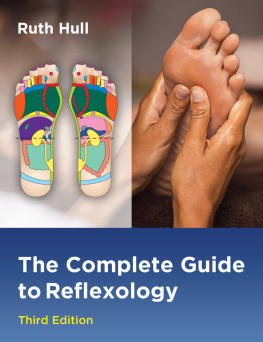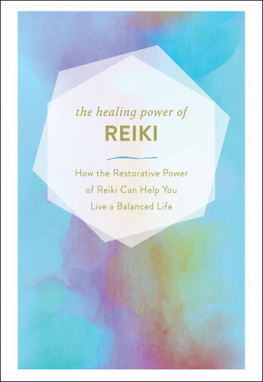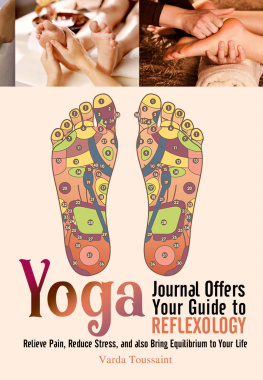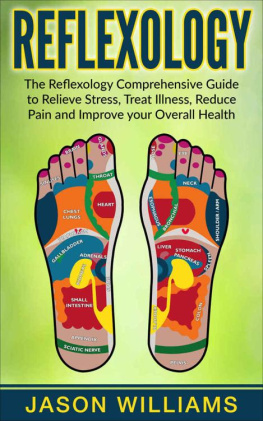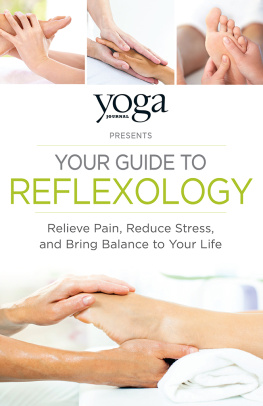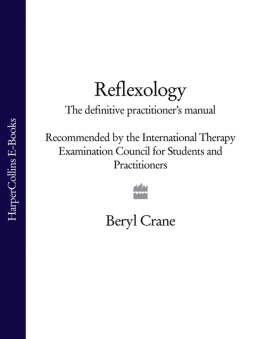Front Matter

The Complete Guide to Reflexology
Third Edition
Ruth Hull

Healing Arts Press
One Park Street
Rochester, Vermont 05767
www.HealingArtsPress.com
Healing Arts Press is a division of Inner Traditions International
Copyright 2011, 2021, 2022 by Ruth Hull
Originally published in the United Kingdom in 2011 by The Write Idea Limited
Second edition published in the U.K. in 2021 by Lotus Publishing
All rights reserved. No part of this book may be reproduced or utilized in any form or by any means, electronic or mechanical, including photocopying, recording, or by any information storage and retrieval system, without permission in writing from the publisher.
Note to the reader: This book is intended as an informational guide. The remedies, approaches, and techniques described herein are meant to supplement, and not to be a substitute for, professional medical care or treatment. They should not be used to treat a serious ailment without prior consultation with a qualified health care professional.
Cataloging-in-Publication Data for this title is available from the Library of Congress
ISBN 978-1-64411-625-8 (print)
ISBN 978-1-64411-626-5 (ebook)
Printed and bound in India by Replika Press Pvt. Ltd.
10 9 8 7 6 5 4 3 2 1
Illustrations Amanda Williams, Vicky Slegg
Pathology Photographs Wellcome Trust Photo Library
Case Study Photographs Tammy Vermaak
Hands and Feet Photographs Cathy Joubert
Text Design and Layout Medlar Publishing Solutions Pvt. Ltd., India
To send correspondence to the author of this book, mail a first-class letter to the author c/o Inner Traditions Bear & Company, One Park Street, Rochester, VT 05767, and we will forward the communication, or contact the author directly at .
Contents
Introduction
This book is for anyone studying to be a professional reflexologist. It presents all the information necessary to gain a thorough understanding of the subject in a clear, accurate and easily absorbed format. We have tried to strike a balance between a friendly, informal tone and serious academic content.
We hope you will enjoy using this book and would welcome any feedback, good or bad, which will help us to improve it in subsequent editions.
General Editor
Maia Vaswani studied microbiology and genetics and human osteoarchaeology, and then took up a position as research assistant in the Entomology Department of the Natural History Museum in London, where she worked for several years.
After brief sojourns in Budapest and Canada, she settled in Brittany and took up freelance copy-editing about ten years ago.
She has recently moved to a cottage in Wales, where she lives with her partner and three cats.
Picture Credits
We would like to thank the following for granting permission to reproduce copyright material in this book:
Photograph of William Hope FitzGerald, MD courtesy of Diana Demms Reddington
Photographs of Eunice Ingham and Dwight Byers courtesy of the International Institute of Reflexology (727) 343-4811, reflexology-usa.net
Anatomical images on pages 40, 5052, 100, 106108, 138, 179 from Sobotta: Atlas der Anatomie des Menschen, 22nd edition Elsevier GmbH, Urban & Fischer Verlag Munchen
Vagus nerve foot reflex on page 138. Reproduced with kind permission from Touchpoint, Denmark. www.touchpoint.dk
What is Reflexology?
Introduction
Reflexology is a gentle, non-invasive therapy that encourages the body to balance and heal itself. It involves applying finger or thumb pressure to specific points on the hands and feet. These points are called reflexes and they reflect, or mirror, the organs and structures of the body as well as a persons emotional health. In this way, the hands and feet are mini maps or microcosms of the body that can be used to encourage holistic healing.
Reflexology is a holistic therapy and the term holistic is derived from the Greek word holos , meaning whole. Holistic therapies such as reflexology are based on the idea that health is the result of harmony between the body, mind and spirit. Stresses of any kind, be they physical, psychological, social or environmental, can upset this balance and cause dis-ease.
In this chapter you will learn more about what reflexology is, where it comes from and how it works.
Student objectives
By the end of this chapter you will be able to:
Describe the history of reflexology
Explain the theory of reflexology
Describe the different theories as to how reflexology works
Explain how stress affects our bodies and how reflexology can help counteract the effects of stress
Describe the benefits of reflexology
Explain when it is not advisable to give reflexology treatments.

History of Reflexology
Ancient times: Egypt, China, India
Healing the body through working the hands and feet is an ancient art that was practised in a number of early cultures. The earliest evidence of hand and foot massage was discovered in Egypt in the tomb of Ankhmahor at Saqqara. The tomb dates back to approximately 2330 BC and is sometimes referred to as the physicians tomb because of all the medical reliefs it contains. Some of these reliefs depict people receiving hand and foot massages, asking that the massages give strength and also do not cause pain.
The ancient Chinese worked the hands and feet to help maintain good health and prevent disease. They developed traditional Chinese medicine, which incorporates acupuncture, acupressure, herbalism and exercise and is based on the medical text Huang-di Nei-jing , or the Inner Classic of the Yellow Emperor. This text, commonly referred to as the Nei-jing, is thought to have been compiled between 300 and 100 BC (Kaptchuk, 1983).
Fundamental to traditional Chinese medicine is the theory that ones vital energy, or life force, runs through 14 major meridians, or channels, in the body. Twelve of these meridians either begin or end in the tips of the fingers and toes, and massage to these areas stimulates the flow of energy and clears congestion in the meridians, thus encouraging harmony in the body. Turn to to explore the meridians and reflexology in more depth.
Infobox
In perspective
A well-known example of how a zone on the body can reflect the health of an organ is when the pain produced by a heart attack is felt as though it is coming from the left arm. The explanation for how this occurs is quite simple sensory nerves from the skin, muscles and organs enter the spinal cord together as bundles, or plexuses, and often share nerve pathways in the spinal cord. Pain that is felt in a different part of the body to where it is produced is known as referred pain .

Referred pain
Evidence of working the hands and feet to improve health is also found in traditional Ayurvedic medicine. Ayurveda developed in India and is considered to be the oldest recorded system of healing, dating back approximately 5000 years. Ayurveda is a Sanskrit word meaning the science of life (Bradford, 1996) and it encompasses not only physical health, but also spiritual and emotional well-being. Foot massage ( padabhyanga ) plays a significant role in Ayurvedic medicine.

